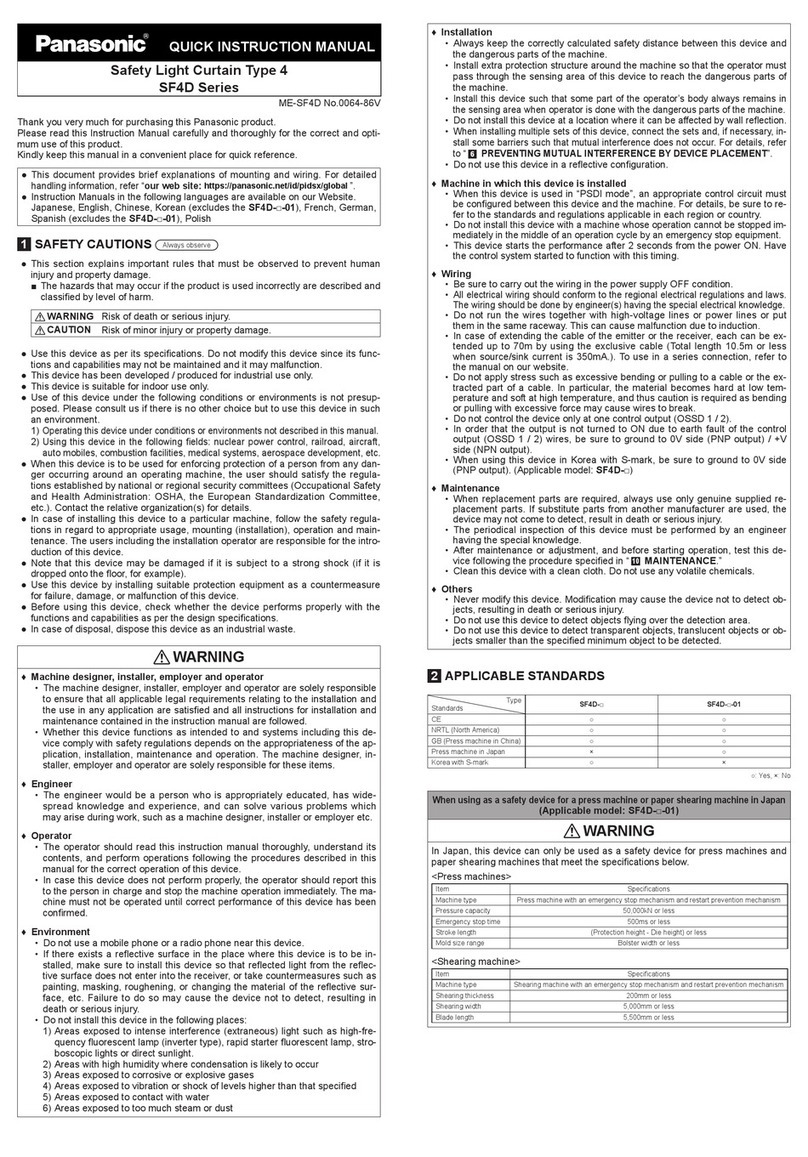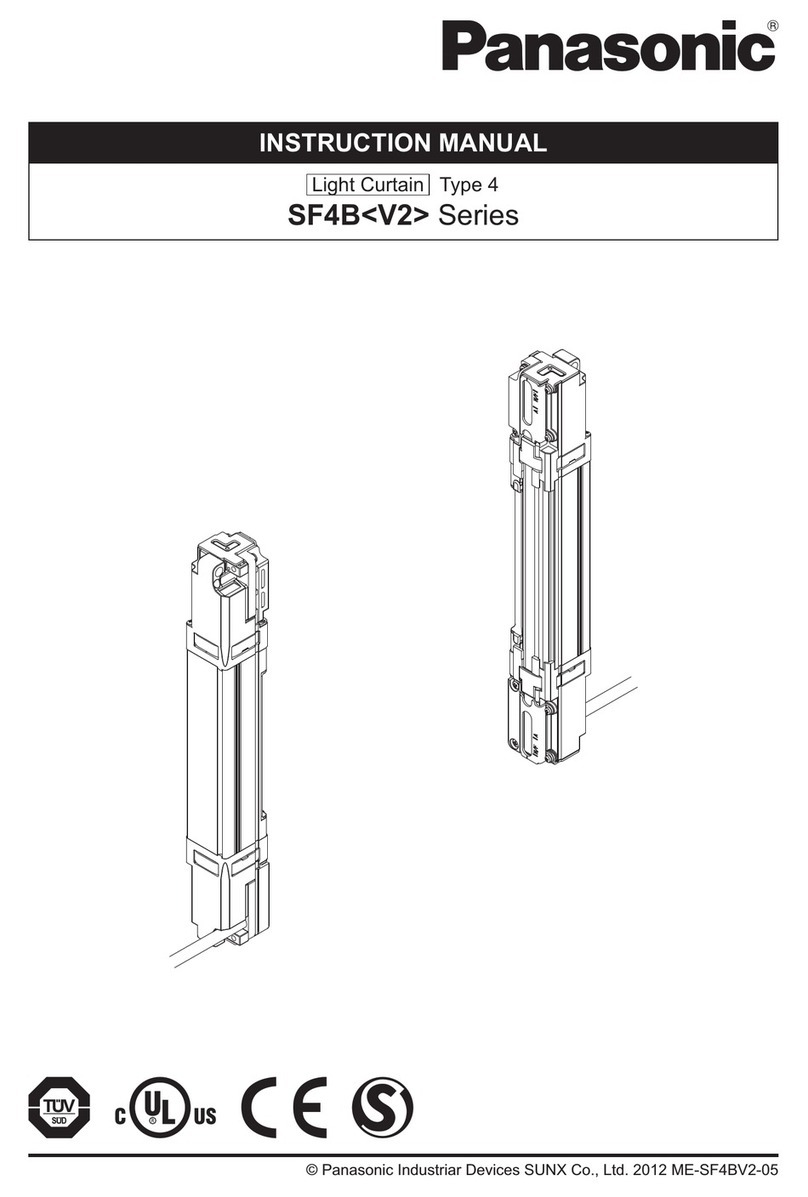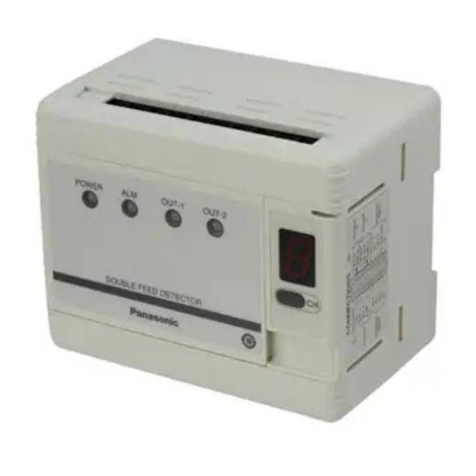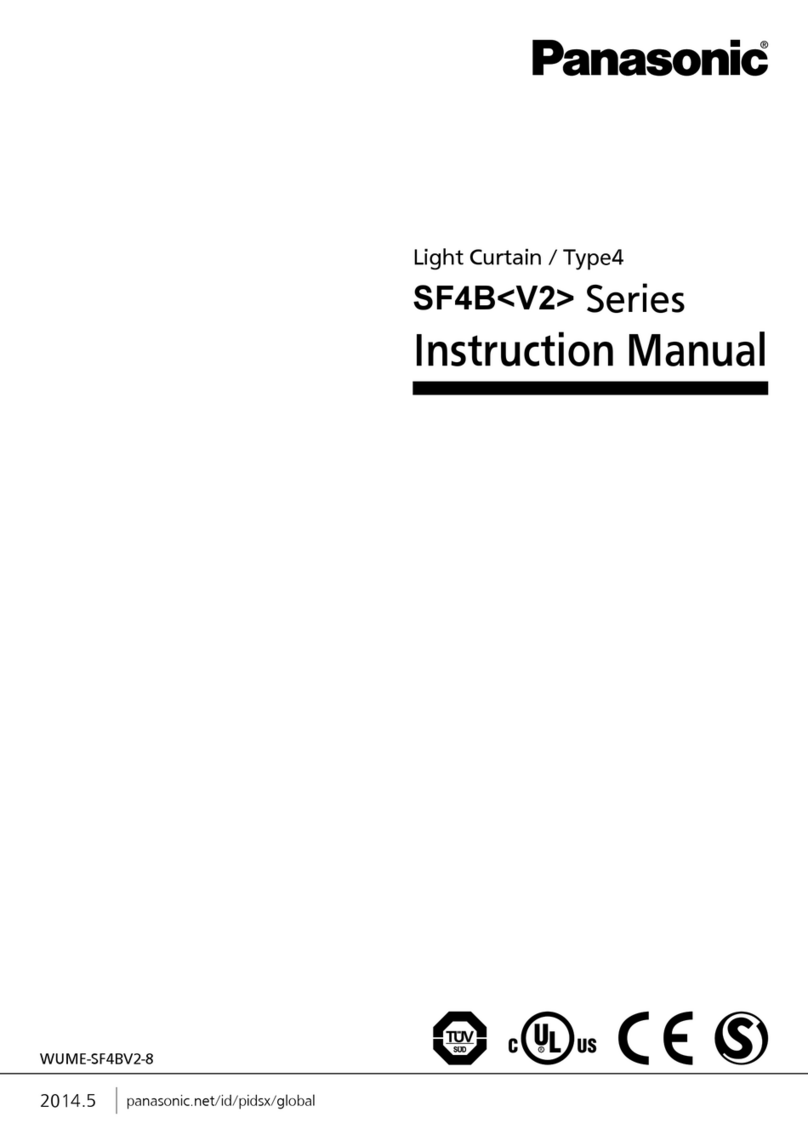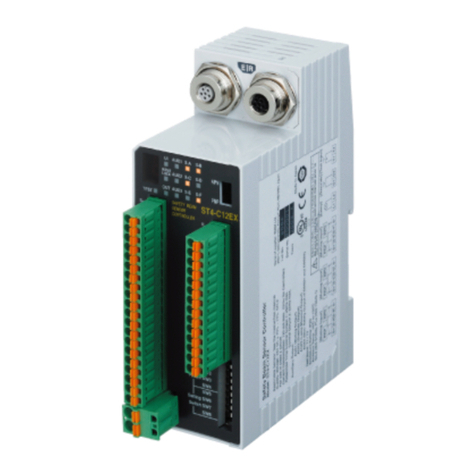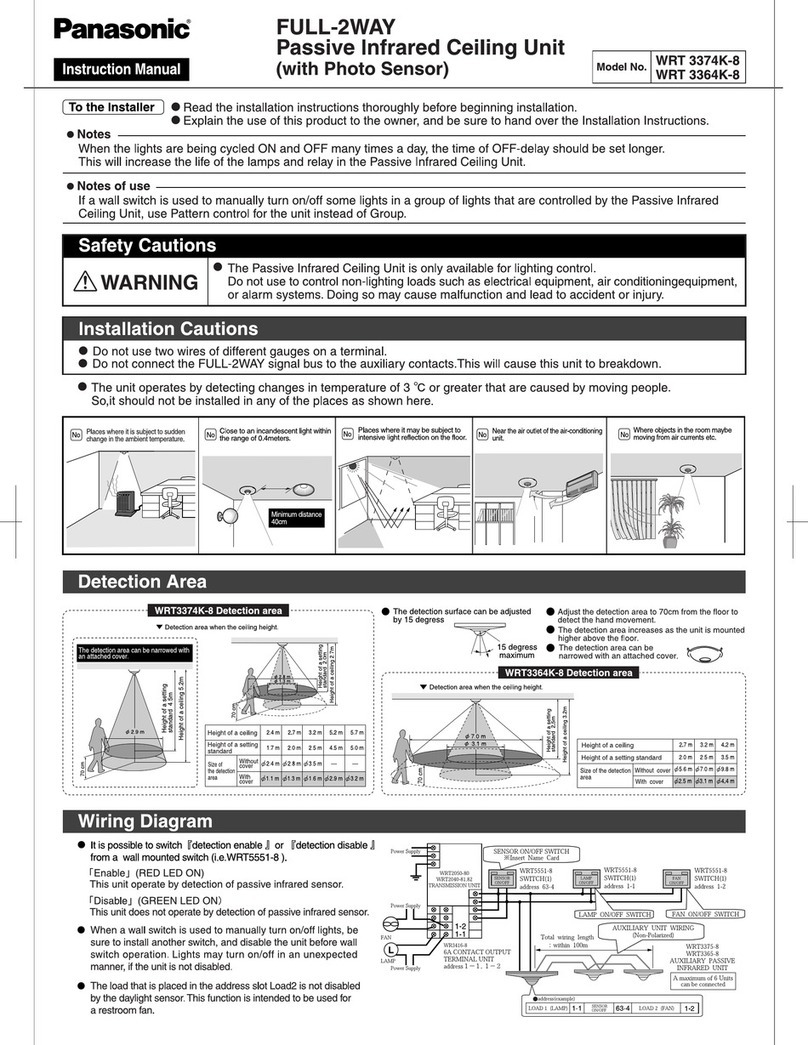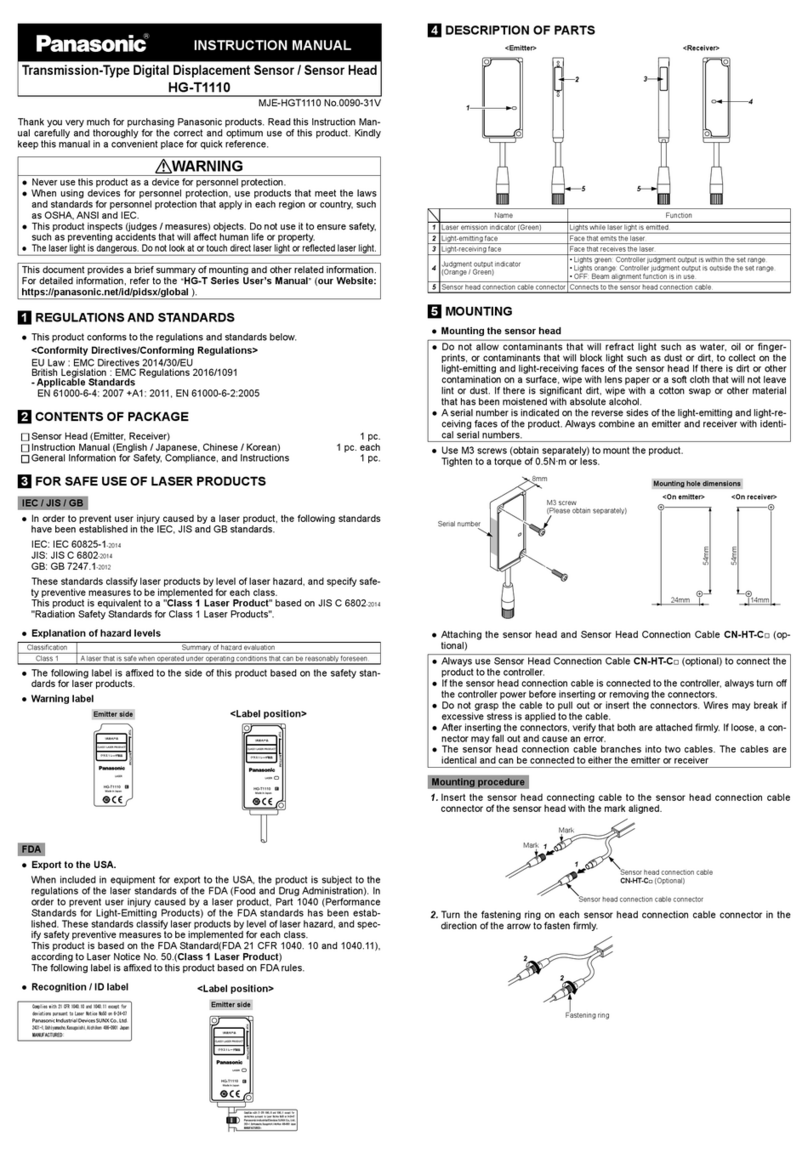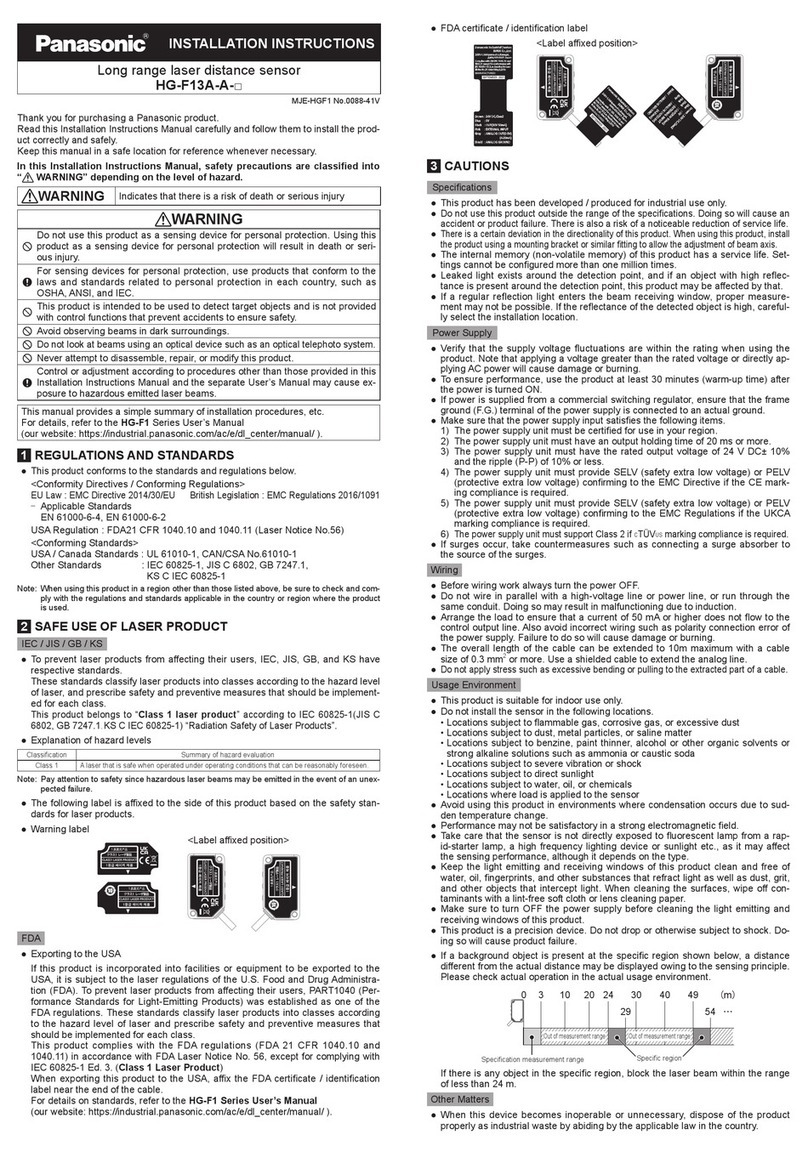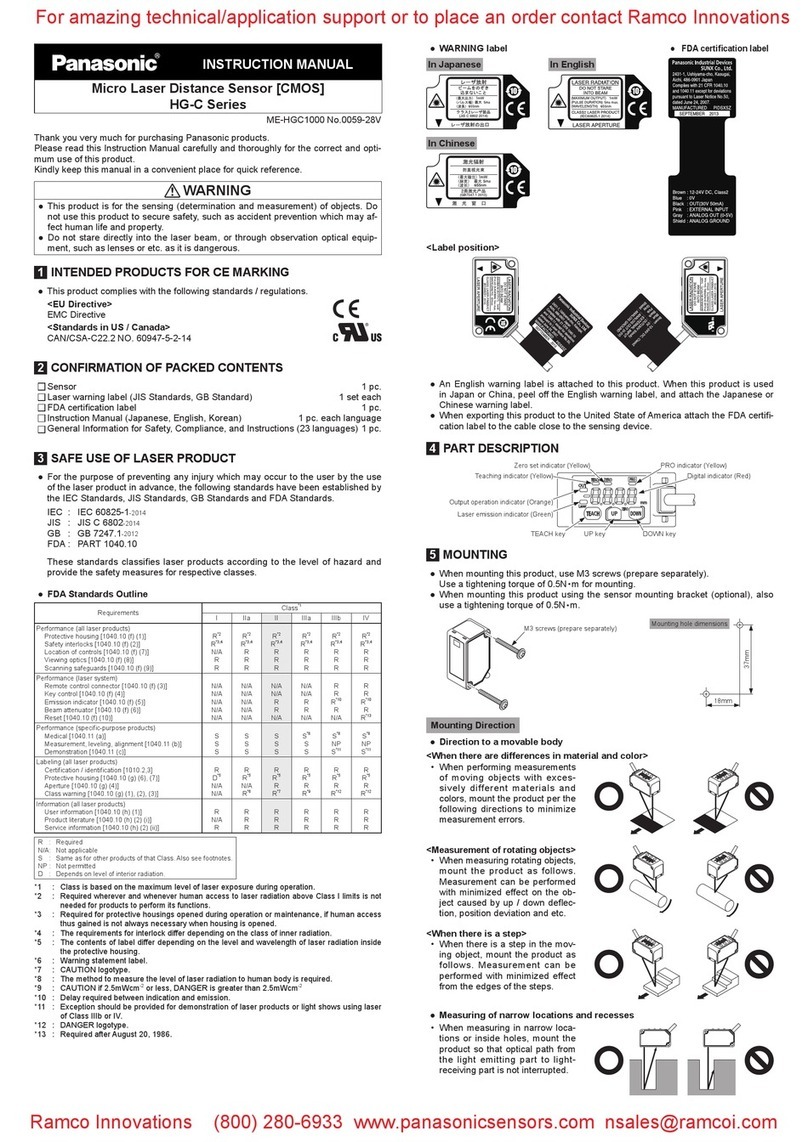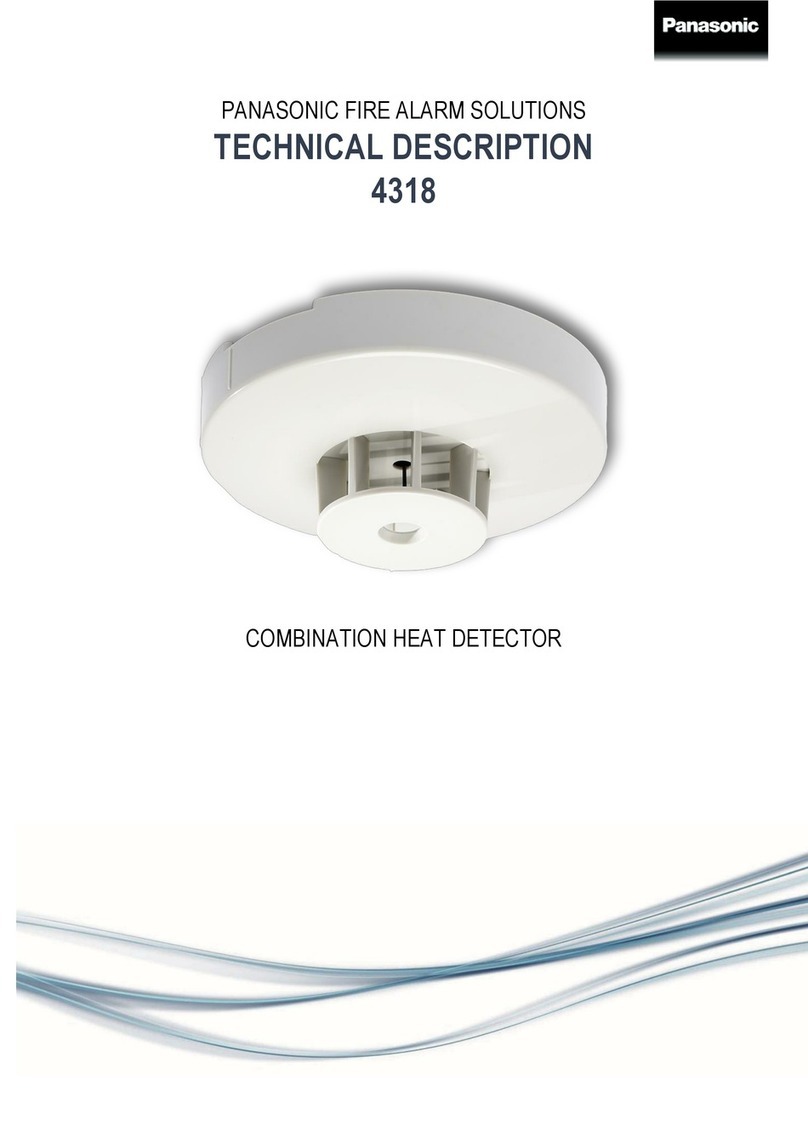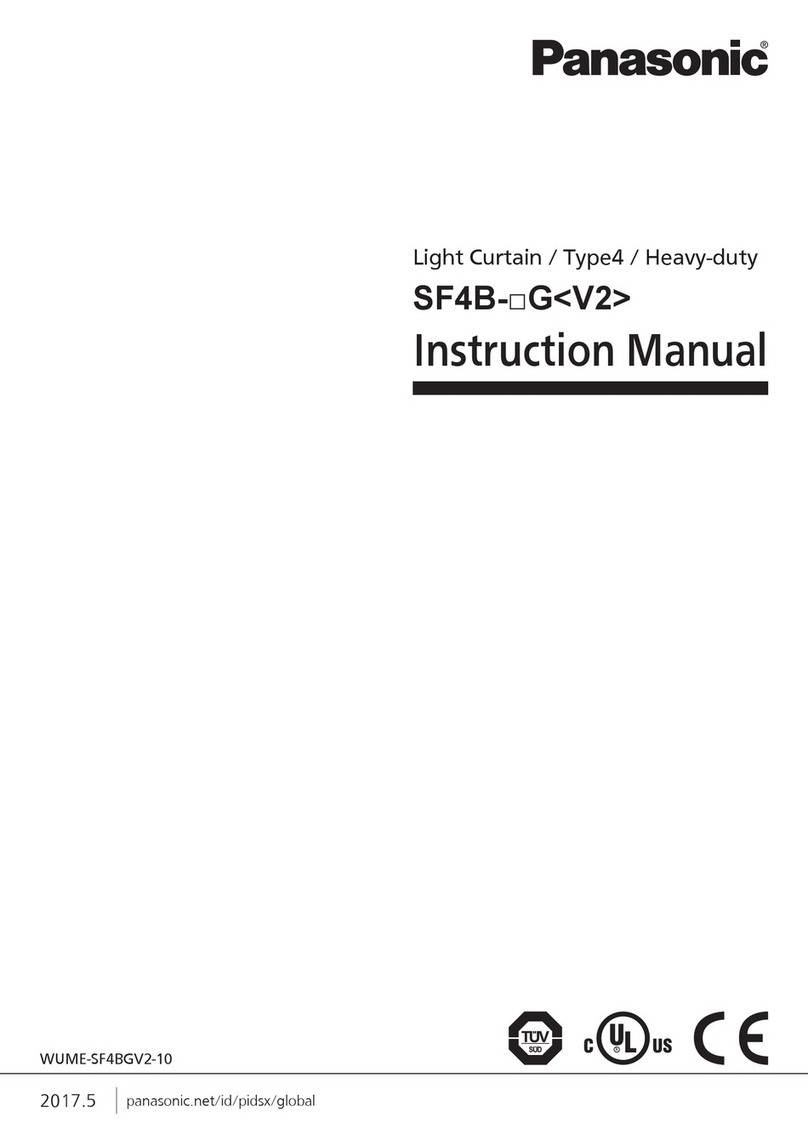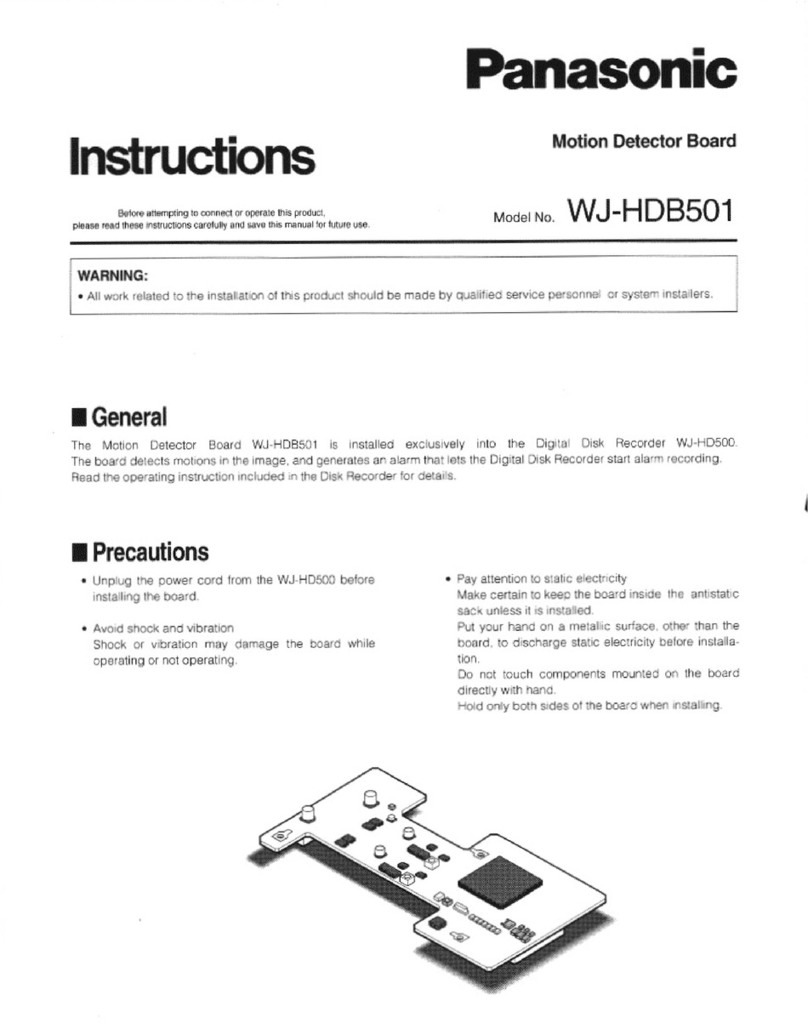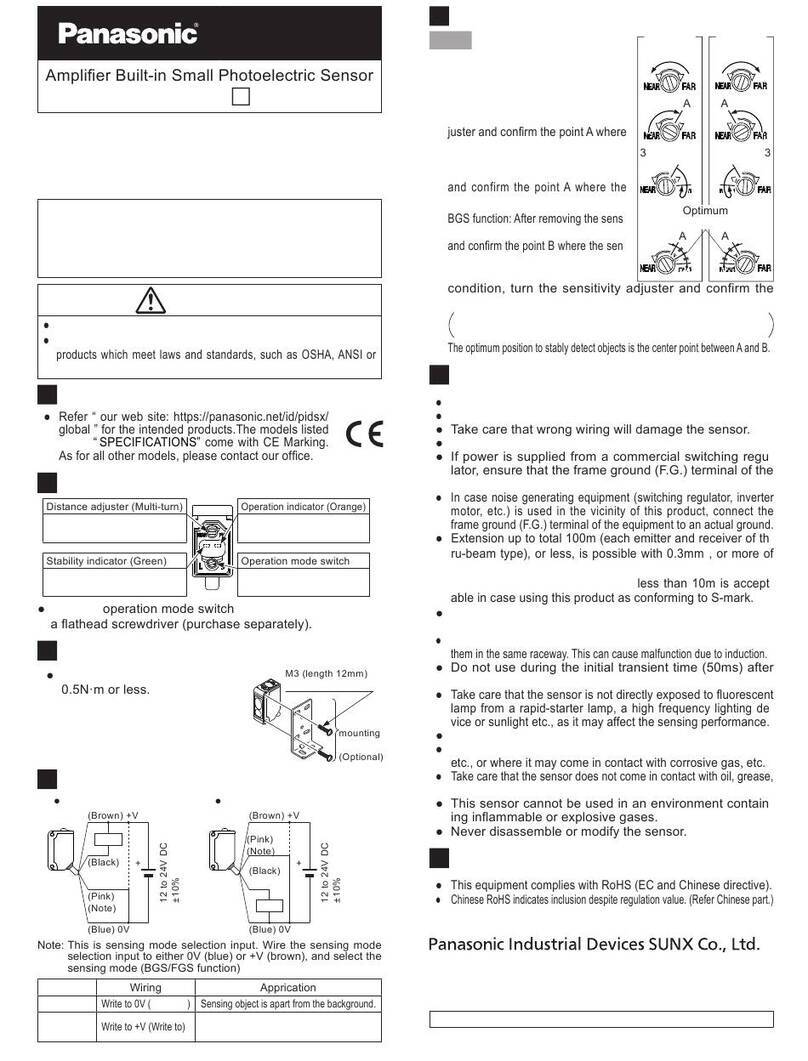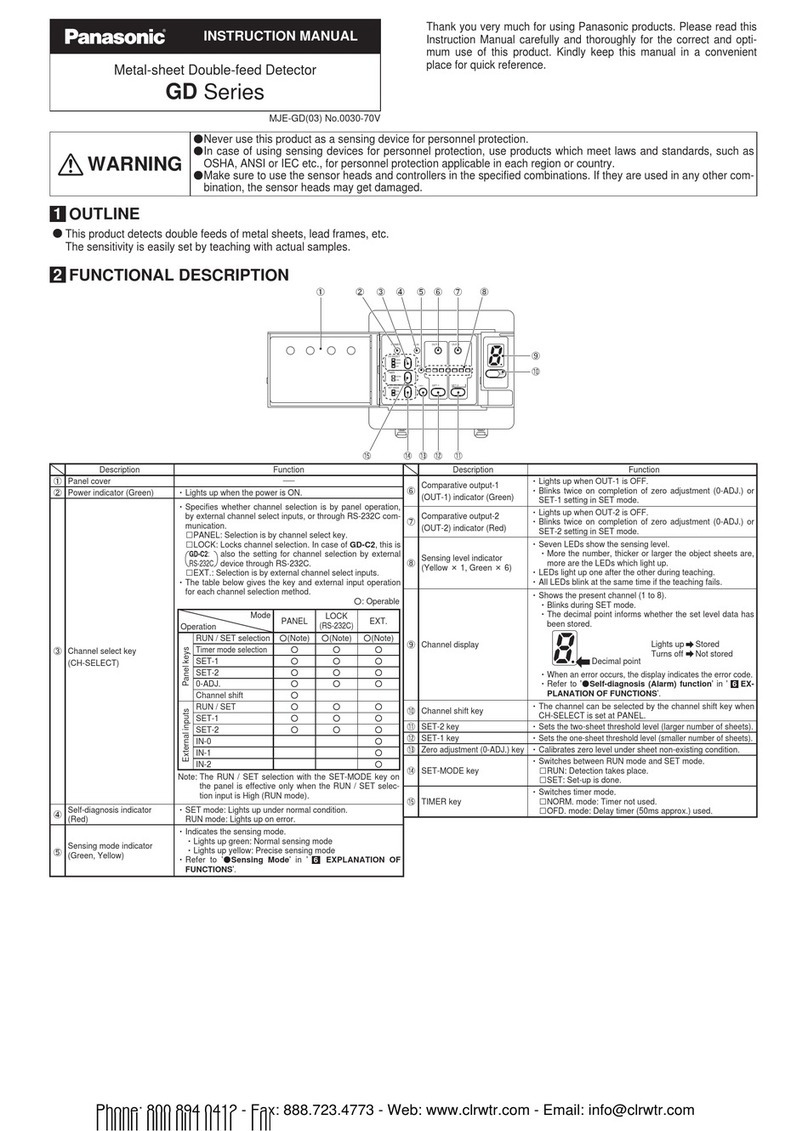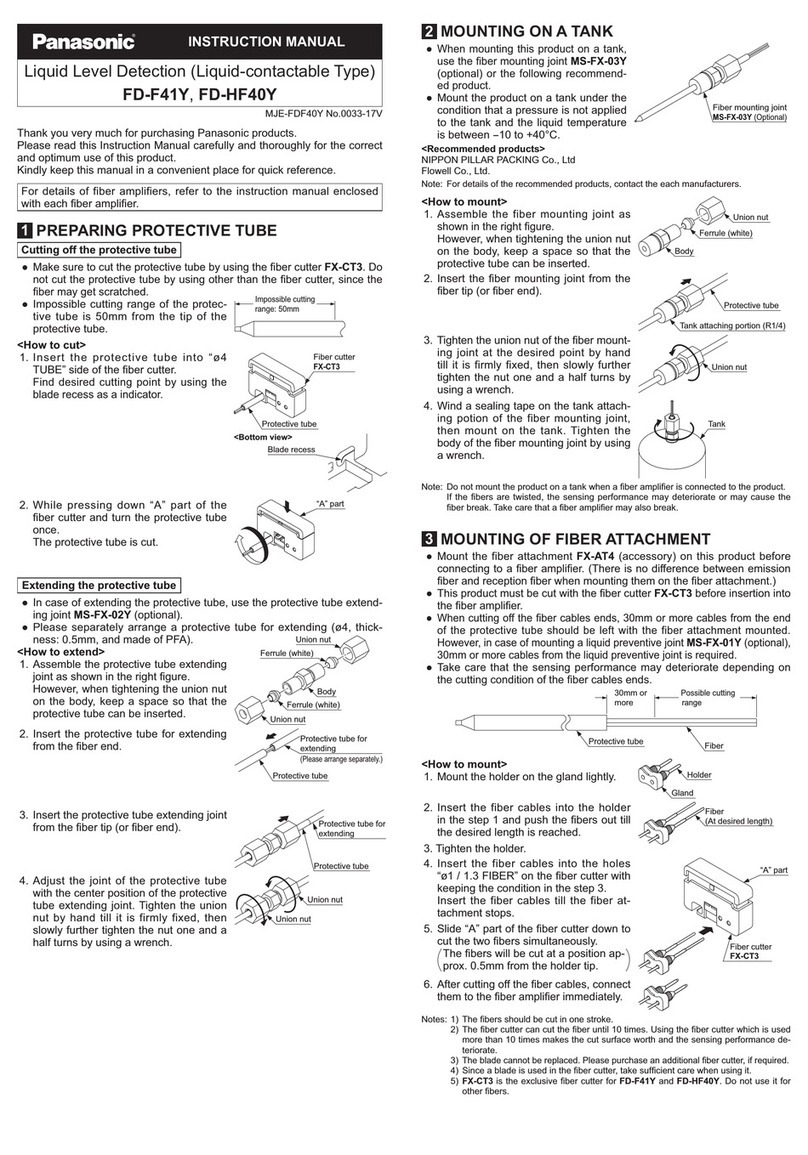CAUTIONS
3
●
●
●
●
●
●
●
●
●
●
●
●
●
●
●
●
This product has been developed / produced for
industrial use only.
Make sure that the power supply is OFF while wiring.
Take care that wrong wiring will damage the sensor.
Verify that the supply voltage variation is within
the rating.
If power is supplied from a commercial switch-
ing regulator, ensure that the frame ground
(F.G.) terminal of the power supply is connect-
ed to an actual ground.
In case noise generating equipment (switching
regulator, inverter motor, etc.) is used in the vicini-
ty of this product, connect the frame ground (F.G.)
terminal of the equipment to an actual ground.
Do not run the wires together with high-voltage
lines or power lines or put them in the same race-
way. This can cause malfunction due to induction.
Extension up to total 100m, is possible with
0.3mm
2
, or more, cable. However, in order to re-
duce noise, make the wiring as short as possible.
Do not use during the initial transient time
(50ms) after the power supply is switched on.
Take care that the sensor is not directly exposed
to fluorescent lamp from a rapid-starter lamp, a
high frequency lighting device or sunlight etc., as
it may affect the sensing performance.
Avoid dust, dirt, and steam. Do not use it in pla-
ces having excessive vapor, dust, etc., or where
it may come in direct contact with corrosive gas.
Take care that the sensor does not come in con-
tact with water, oil, grease, organic solvents, such
as, thinner etc., strong acid or alkaline.
This sensor is suitable for indoor use only.
Make sure that stress by forcible bend or pulling
is not applied directly to the sensor cable joint.
Since the cable end is not waterproof, do not
use the sensor in the application where water
may seep in from the cable end.
When connecting the mating cable to the con-
nector type sensor, the tightening torque should
be 0.4N・m or less.
SPECIFICATIONS
1
NPN open-collector transistor
・Maximum sink current: 100mA
・Applied voltage: 30V DC or less
(between output and 0V)
・Residual voltage: 1V or less
(at 100mA sink current)
0.4V or less
(at 16mA sink current)
PNP open-collector transistor
・Maximum source current: 100mA
・Applied voltage: 30V DC or less
(between output and +V)
・Residual voltage: 1V or less
(at 100mA source current)
0.4V or less
(at 16mA source current)
<Far (Main) output, Near (Sub) output>
NPN open-collector transistor
・Maximum sink current: 100mA
・Applied voltage: 30V DC or less
(between output and 0V)
・Residual voltage: 1V or less
(at 100mA sink current)
0.4V or less
(at 16mA sink current)
90mA or less55mA or less50mA or less
0.1 to 2m
Far (Main): 0.1 to 2m
Near (Sub): 0.2 to 2m
[with Near (Sub) distance for adjuster at max.]
Output
Current consumption
Hysteresis 10% or less of operation distance (With white non-glossy paper)
0.2 to 2m Far (Main): 0.2 to 2m
Near (Sub): Refer to diagram in (Note 3)
EQ-34
EQ-34-PN
EQ-34W
NPN output type PNP output type Two outputs type
Model No. (Note 1)
Type
Item
Adjustable range (Note 2)
Adjustable range reflective
10 to 30V DC Ripple P-P 10% or lessSupply voltage
Sensing range
with white non-glossy paper
at setting distance 2m
Red LED (lights up when the output is ON)
Far (Main) output: Red LED
[lights up when the Far (Main) output is ON]
Near (Sub) output: Red LED
[lights up when the Near (Sub) output is ON]
Operation indicator
Switchable either Detection-ON or Detection-OFF
Incorporated
Output operation
Short-circuit protection
2ms or lessResponse time
Far (Main): 2-turn mechanical ad-
juster with pointer
Near (Sub): Variable adjuster
Green LED (lights up under stable light received condition or stable dark condition) (Note 4)Stability indicator
2-turn mechanical adjuster with pointerDistance adjuster
Cable 0.3mm23-core cabtyre cable, 2m long
0.3mm
2
4-core cabtyre cable, 2m long
2-segment photodiodeReceiving element
Adjusting screwdriver: 1pc.Accessory
Infrared LED (modulated)
Enclosure: Polyalylate and Polyethylene terephthalate, Lens: PolyalylateMaterial
IP67 (IEC)Protection
-20 to +55℃(No dew condensation or icing allowed), Storage: -25 to +70℃Ambient temperature
35 to 85% RH, Storage: 35 to 85% RHAmbient humidity
Emitting element
Incorporated (Note 5)
Automatic interference
prevention function
Approx. 150gWeight
Notes: 1) The model No. with suffix '-J' stands for the connector type. (EQ-34W is excluded.)
(e.g.) As for the connector type of EQ-34: 'EQ-34-J'
Use the mating cables as shown below.
CN-24L-C2 (Elbow type, 4-core, 2m)
CN-24L-C5 (Elbow type, 4-core, 5m)
CN-24-C2 (Straight type, 4-core, 2m)
CN-24-C5 (Straight type, 4-core, 5m)
4)
5)
Refer to ' STABILITY INDICATOR' for the details of the stability indicator.
Detection may become unstable depending on the setting conditions or the sensing objects. After setting up this product, make
sure to check operations using actual sensing objects.
5
2)
The model No. with suffix '-C5' stands for the 5m cable length type. (EQ-34-PN is excluded.)
(e.g.) As for the 5m cable length type of EQ-34 'EQ-34-C5'
The adjustable range stands for the maximum sensing range which can
be set with the adjuster. The sensor can detect an object 0.1m, or more,
away. However, the detectable area of the Near (Sub) type of the
EQ-34W begins at 0.2m.
0.2m
0.1m
2m
Non-detectable range
Actual sensing
range of the sensor
Adjustable range
Sensing
object
3)
The Near (Sub) distance adjustable range, L
2
, changes with the setting of the Far (Main) distance, L
1
, as shown in the table below.
EQ-34W Near (Sub) distance adjustable range
EQ-34W
Far (Main) setting distance L1Near (Sub) distance
adjustable range L2
2m 1 to 2m
0.2m 0.2m
1.5m 0.85 to 1.5m
1m 0.65 to 1m
0.5m 0.35 to 0.5m
0 0.5 1 1.5 2
2
1.5
1
0.5
Far (Main) setting distance L1(m)
Near (Sub) distance
adjustable range
L2(m)
MOUNTING
4
●The tightening torque should be 0.8N・m or
less.
M4 nut
M4 (length 25mm)
screw with washers
Sensor
mounting
bracket
MS-EQ3-2
(Optional)
●Care must be taken regarding the sensor
mounting direction with respect to the object's
direction of movement.
Do not make the sen-
sor detect an object
in this direction be-
cause it may cause
unstable operation.
Sensing object
Not good
Sensing object
Good
Sensing object
Good
●
●
When detecting a specular object (aluminum or
copper foil, etc.) or an object having a glossy
surface or coating, please take care that there
are cases when the object may not be detected
due to a small change in angle, wrinkles on the
object surface, etc.
When a specular body is present below the
sensor, use the sensor by tiling it slightly up-
wards to avoid wrong operation.
Specular face
Not good
Tilt
Good
Specular face
●
●
Never use this product as a sensing device for personnel protection.
In case of using sensing devices for personnel protection, use products which meet laws and stand-
ards, such as OSHA, ANSI or IEC etc., for personnel protection applicable in each region or country.
WARNING
●
The models listed under ' SPECIFICATIONS'
come with CE Marking.
As for all other models, please contact our office.
1
INTENDED PRODUCTS FOR
CE MARKING
2
Ad


